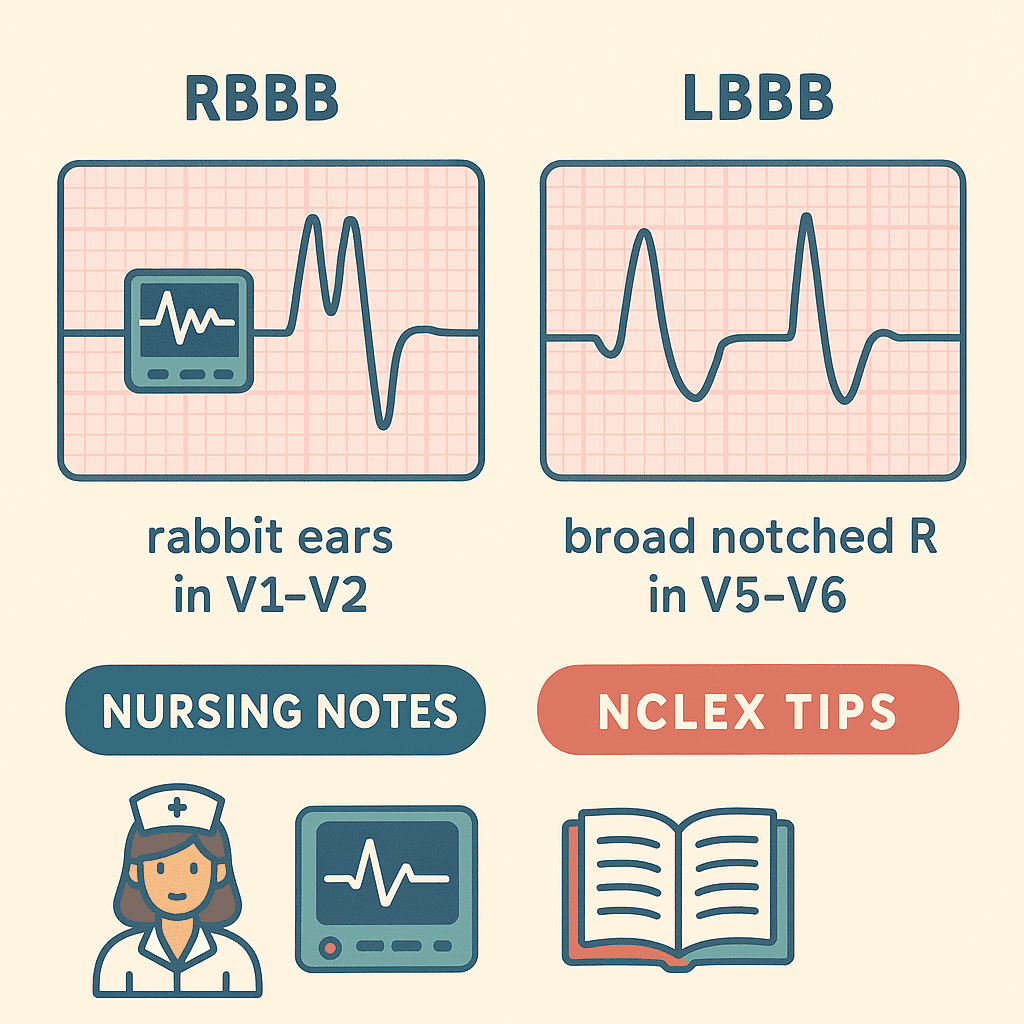For every nurse preparing for the NCLEX, heart rhythm interpretation is a must-know skill. One of the trickier concepts is bundle branch blocks (BBBs). Whether you’re a registered nurse (RN nurse) or a student working through a nursing bundle, breaking down right and left bundle branch blocks into simple patterns makes them much easier to understand and remember.
✅ What is a Bundle Branch Block?
A bundle branch block occurs when there is a delay or blockage in the electrical conduction pathway of the heart, specifically in the right or left bundle branches. This affects how the ventricles contract and shows up as distinct ECG changes.
- Right Bundle Branch Block (RBBB): The right ventricle contracts later than the left.
- Left Bundle Branch Block (LBBB): The left ventricle contracts later than the right.
🔹 Right Bundle Branch Block (RBBB)
ECG Features:
- Wide QRS (> 0.12 seconds).
- “Rabbit ears” (RSR’) in leads V1 and V2.
- Slurred S waves in leads I and V6.
Clinical Significance for Nursing:
- May be benign or related to heart disease.
- Monitor for worsening symptoms like chest pain or syncope.
NCLEX Tip for RN Nurses:
Think “RBBB = Right V1 rabbit ears” to remember the ECG finding.
🔹 Left Bundle Branch Block (LBBB)
ECG Features:
- Wide QRS (> 0.12 seconds).
- Broad, notched R waves in leads I, aVL, V5, and V6.
- Deep S waves in V1 and V2.
Clinical Significance for Nursing:
- Often associated with more serious cardiac disease (e.g., myocardial infarction, hypertension, cardiomyopathy).
- Requires immediate evaluation when new onset is found.
NCLEX Tip for Nurses:
Think “LBBB = Left lateral leads (I, aVL, V5, V6)” for recognition.
🩺 Nursing Priorities in Bundle Branch Blocks
For nurses and RN nurses, the role is not to diagnose BBBs but to:
- Recognize the ECG pattern.
- Assess symptoms (dizziness, chest pain, syncope).
- Notify the healthcare provider.
- Prepare for further testing (echo, stress test).
- Educate patients about follow-up and possible cardiac risk factors.
📘 Nursing Bundle Study Tip
When studying arrhythmias in your nursing bundle, group BBBs with other wide-QRS conditions like ventricular tachycardia. This helps you distinguish life-threatening rhythms from conduction delays, a common NCLEX exam trick.
🧠 Quick Memory Trick for NCLEX
- RBBB → V1 = RSR’ (“rabbit ears”).
- LBBB → Lateral leads = broad, notched R wave.
👉 Remember: “Turn signal rule” –
- RBBB = terminal R wave in right chest leads (V1, V2).
- LBBB = terminal R wave in left chest leads (V5, V6).
Final Thoughts
For a nurse preparing for the NCLEX, bundle branch blocks can seem intimidating. But with simplified patterns and quick mnemonics, they’re manageable. As a registered nurse, recognizing RBBB vs. LBBB on an ECG helps ensure timely communication with providers and safe patient care. Keep adding these cardiac topics into your nursing bundle study plan to stay confident and exam-ready.
❓ FAQs: Bundle Branch Blocks for Nursing Students
A Bundle Branch Block happens when there’s a delay or block in the electrical signals traveling through the heart’s ventricles. On an ECG, this appears as a wide QRS complex. Nurses and RN nurses should recognize this pattern quickly, especially for NCLEX questions.
RBBB: Look for the “rabbit ears” pattern (RSR’) in leads V1–V2.
LBBB: Look for a broad, notched R wave in leads V5–V6.
NCLEX tip: “RBBB = Right-sided leads (V1–V2). LBBB = Left-sided leads (V5–V6).”
Not always. RBBB can sometimes be benign, especially in young healthy individuals. However, LBBB is more often linked to underlying cardiac disease. As a nurse, always assess the patient’s overall condition, not just the ECG strip.
Monitor vital signs and oxygenation.
Assess for chest pain, dyspnea, or syncope.
Notify the healthcare provider.
Prepare for possible cardiac workup (e.g., echocardiogram, troponins).
Registered nurses should remember: patient safety first, then documentation.
The NCLEX often tests recognition of wide QRS complexes and the difference between RBBB vs LBBB. Nursing bundles and study sheets usually include ECG visuals to help RN nurses remember these key differences.
Not always. The treatment depends on the cause. Sometimes no intervention is needed, but in cases of heart disease, medications like beta-blockers, ACE inhibitors, or even pacemakers may be considered. Nurses should focus on monitoring and reporting changes.

